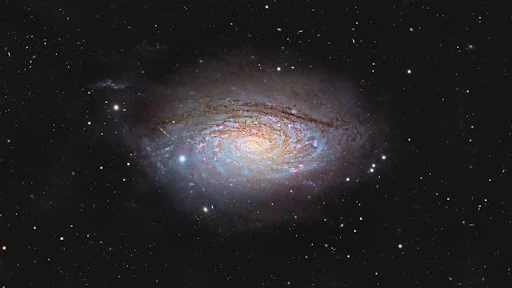Amateur astrophotographer Ronald Brecher captured a stunning image of the Sunflower Galaxy (Messier 63) from his backyard observatory near Guelph, Ontario, Canada. The detailed portrait showcases the galaxy's spiral arms, resembling a cosmic sunflower, illuminated by countless newly formed stars. The image was published on Space.com on May 18, 2025.
Details of the Image and Capture:
- Object: Sunflower Galaxy (Messier 63, NGC 5055)
- Photographer: Ronald Brecher
- Location: Near Guelph, Ontario, Canada
- Date: Nights of April 17-28, 2025
- Telescope: Celestron 14" EDGE HD
- Camera: Monochrome astronomy camera
- Filters: Red, green, blue, and hydrogen-alpha filters
- Exposure Time: Over 13 hours (158 exposures)
- Processing Software: PixInsight
About the Sunflower Galaxy (Messier 63):
- Nickname: The galaxy's spiral arm structure and bright central core bear a striking resemblance to a sunflower.
- Type: Spiral galaxy, classified as SA(rs)bc, indicating a spiral shape without a central bar and moderately to loosely wound arms. It's also considered a flocculent spiral galaxy due to its discontinuous and patchy arm structure.
- Location: Constellation Canes Venatici (the Hunting Dogs)
- Distance: Approximately 27-29.3 million light-years from Earth.
- Size: Roughly 110,000-130,000 light-years in diameter, similar in size to our Milky Way.
- Number of Stars: Approximately 400 billion.
- Brightness: Apparent magnitude of around 9.3. It appears as a faint smudge of light in smaller telescopes under good viewing conditions.
- Structure: Features a bright yellow central core and numerous spiral arm segments dotted with young, hot, blue-white stars, indicating active star formation. Dark dust lanes are also prominent within the arms.
- Notable Features:
- It belongs to the M51 Group of galaxies, which also includes the Whirlpool Galaxy (M51).
- M63 has a weakly active galactic nucleus (LINER).
- Infrared observations reveal a symmetric two-armed spiral structure.
- Radio observations show a warped gaseous disk extending far beyond the visible disk.
- One supernova (SN 1971I) was observed in M63 in 1971.
- Best Time to View: Spring and early summer in the Northern Hemisphere, particularly May. It can be found by locating the bright stars Arcturus in Bootes and Dubhe in the Big Dipper; M63 lies roughly halfway between them.
Brecher's dedication, even with challenging weather conditions, highlights the impressive capabilities of amateur astrophotography in capturing the beauty and detail of distant galaxies like the cosmic sunflower.

